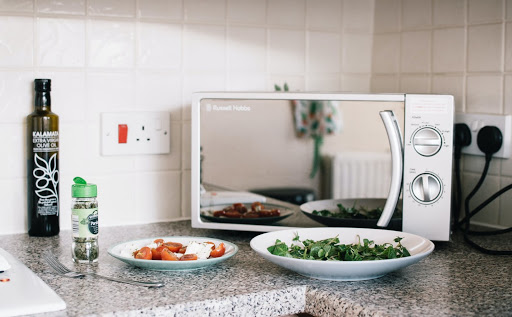Is anything easier than the microwave? You put in some leftover food and in a couple minutes, you have yourself a hot, yummy meal.
While microwaves can make getting food on the table a faster and easier process, we want to make sure your food is safe and delicious. Here are some essential tips:
Most importantly, we want to make sure that our food cooks!
- Spread your food evenly on a plate. It’s best to leave an open space in the center of the plate and place your food closer to the edges of the plate so it sits in a circle on your plate. The more surface area the food takes up on the plate, the better it will heat. Remember to cook or reheat in small portions for best heating.
- Stir your food. A microwave does not give the strong heating that an oven or stove provides. Stir your food occasionally to spread the heat and cook your food fully.
- Liquid foods, like soup, should be cooked to 165 degrees Fahrenheit. Harmful bacteria is gotten rid of only when food is cooked to proper temperatures! Not all of us have a food thermometer. An easy way to be sure that you’ve reached a safe temperature is to make sure that there are bubbles! You want to also see steam coming off the top of the food.
- Many of us use the microwave to thaw our meat. Once meat is defrosted, be sure to fully cook right after either in the microwave or using the stove, oven, or grill. Use a food thermometer inserted in the thickest part to make sure the meat is cooked to the correct temperature.
The microwave can get DIRTY!
-
- Cover your food. This will prevent food from getting everywhere. It also allows the food to hold moisture and helps heat distribute well through your food.
- When cleaning, don’t forget to look at the top surface and door of the microwave. Hot water, a clean cloth, and detergent will do.
- Clean your microwave using lemon! Take a half cup of water and pour it into a bowl. Squeeze half a lemon into the bowl of water and throw in the lemon half as well. Microwave the bowl on high power for three minutes or until the liquid comes to a boil. Let stand for five minutes – this will allow the steam trapped inside to loosen up any dirt in your microwave. Now finally open the microwave door, remove the bowl and wipe the inside of the microwave clean! Be careful – the bowl may still be hot.
Healthy cooking
- The microwave is great for cooking up your veggies! Vegetables cooked in the microwave will have more nutrients like vitamin C and vitamin B complex.
- Get the most out of your lemon! Microwaving a lemon for 10-20 seconds or until the skin is warm to touch will make the inside of the lemon more soft which allows you to get more juice out of your lemons.
Safety is always the most important priority.
If you are unsure whether your container is “microwave-safe”, place the container in the microwave with no food or liquid with another microwave-safe container that is filled with water. Heat for 1 minute on high. If the outside of the container is not heated, it is microwave-safe! If it’s warm, it’s okay to use the container for reheating only. Do not use the container if it is hot after heating.
No one wants chemicals leaking into their foods. Use glass, ceramic, and microwave-safe containers to heat up food, rather than plastic. Plastic wraps and foam trays may cause harmful chemicals to get into your food.
Microwaves are great for quick and efficient cooking.
For further information, visit USDA’s website on Food Safety Education at, https://www.fsis.usda.gov/wps/portal/fsis/topics/food-safety-education/get-answers/food-safety-fact-sheets/safe-food-handling/keep-food-safe-food-safety-basics/CT_Index
Written by Ann Abraham


